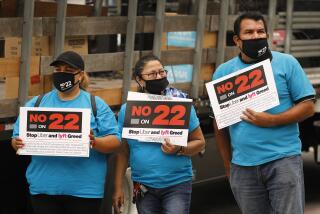Supreme Court makes age bias suits harder to win
- Share via
WASHINGTON — With workplace age-discrimination claims rising rapidly, the Supreme Court made it much harder Thursday for older workers to win in court.
The 5-4 decision reversed a long-standing rule. Many federal appellate courts had decided that if a worker could show age was one of the factors in a layoff or demotion, then the employer was required to prove it had a legitimate reason for its action apart from age.
The court’s conservative majority, led by Justice Clarence Thomas, threw out this two-step approach. Instead, the court said, workers bear the full burden of proving that age was the deciding factor in their dismissal or demotion.
Because workers claiming such discrimination almost certainly will not be present while their employers discuss laying them off or demoting them, analysts said, it will be extremely difficult to obtain hard evidence that age was the key factor.
“This is a significant and marked change,” said Diana Hoover, a corporate defense lawyer in Houston. “It imposes a difficult burden on the employee. You are not going to have an employer stand up and announce, ‘I’m discriminating against you because of your age.’ ”
The ruling comes as concern about age discrimination is rising, especially as companies downsize in the difficult economy. The U.S. Equal Employment Opportunity Commission said the number of new age-bias claims last year rose by 29% from 2007.
Businesses applauded the decision in Gross vs. FBL Financial Services, saying employers sometimes settle weak claims to avoid battling before a jury over the real reasons behind a layoff.
“This is extremely important to small-business owners,” said Karen Harned, executive director of the National Federation of Independent Business. She said employers should not have to defend themselves in court “based on speculative evidence that age was merely a motivating factor in an employer’s decision.”
But the National Senior Citizens Law Center, AARP and several civil rights groups sharply criticized it, urging Congress to trump the ruling with legislation.
Senate Judiciary Committee Chairman Patrick J. Leahy (D-Vt.) likened it to the Lilly Ledbetter decision from two years ago.
In that case, the same 5-4 majority said a woman who for years had been paid less than men for the same work could not sue because she had not learned about the discrimination until she retired -- long after the statute of limitations had expired.
Congress passed a bill to reverse the Ledbetter decision early this year. President Obama made it the first measure he signed into law.
Leahy said in a statement that the age-bias decision “reminds me of the court’s wrong-headed ruling in Ledbetter. Five justices acted to disregard precedent and ignore the plain reading and common understanding of the statute that Congress passed to protect Americans from discrimination based on their age.”
The court said the two-step rule could still be applied in bias cases involving discrimination claims on the basis of race, sex, religion or national origin.
But age-bias claims must adhere to a stricter standard, Thomas said: An older worker must prove “that age was the reason” behind the employer’s action.
In discrimination lawsuits involving what lawyers call “mixed motive” cases, a worker previously might have had a valid claim of discrimination if age or another prohibited factor, such as race, was one of the motivations behind a firing or demotion.
Thomas acknowledged that Congress and the Supreme Court had authorized this approach, but he said it could not be applied to age discrimination cases.
“The burden of persuasion does not shift to the employer,” he said, “even when a plaintiff has produced some evidence that age was one motivating factor in that decision.”
In 1991, Congress amended the law covering discrimination on the basis of race, sex, religion and national origin to allow mixed-motive claims. It did not revise the age bias law. Thursday’s majority said that age, therefore, should be treated differently.
Joining Thomas were Chief Justice John G. Roberts Jr. and Justices Antonin Scalia, Anthony M. Kennedy and Samuel A. Alito Jr.
The dissenters, led by the court’s senior justice, John Paul Stevens, described the ruling as “especially irresponsible” and “an unabashed display of judicial lawmaking.” Stevens seemed particularly upset that the court had decided a different issue than it had announced when it accepted the case last year.
“Unfortunately, the majority’s inattention to prudential court practices is matched by its utter disregard of our precedent and Congress’ intent,” he wrote.
Justices Ruth Bader Ginsburg, David H. Souter and Stephen G. Breyer joined his opinion.
The dissenters maintained that if older workers could show some evidence that age had entered into the decision to fire or demote them, then the employer should be required to show it had a good and legitimate reason for its decision independent of age.
Thursday’s ruling overturned a $47,000 jury verdict in favor of Jack Gross, 54, an Iowa insurance claims adjuster. He was demoted in a company reorganization, and his job was given to a woman in her 40s.
Gross sued under the Age Discrimination in Employment Act, which bars bias against those over 40.
The judge instructed jurors that they should rule for Gross if his age was “a motivating factor” in the employer’s decision to demote him and if the employer had failed to show that it would have made the same decision regardless of his age.
The high court majority said the judge had erred by allowing the plaintiff to win without proving he had been demoted because of his age.
A year ago, the court took a nearly opposite tack involving class-action cases, in which groups of older workers contend that a company’s overall layoff policies discriminate against them. In a 7-1 ruling -- with only Thomas dissenting -- the court ruled that the company must defend its policies as reasonable.
Thursday’s decision involved claims by individuals rather than a group.
“You don’t see a lot of cases involving entire classes of employees,” said Paul W. Mollica, a Chicago lawyer who handles job discrimination suits. “Virtually all the cases are like the one decided today, involving an individual.”
--
More to Read
Inside the business of entertainment
The Wide Shot brings you news, analysis and insights on everything from streaming wars to production — and what it all means for the future.
You may occasionally receive promotional content from the Los Angeles Times.











